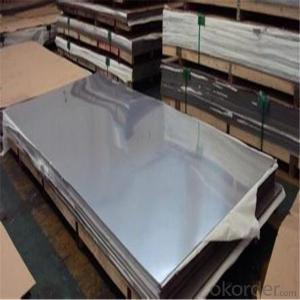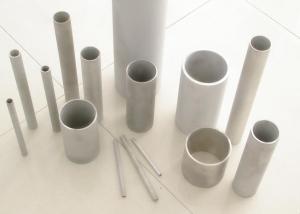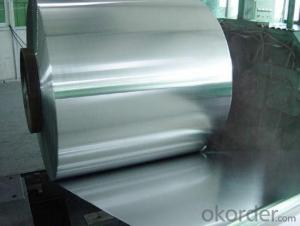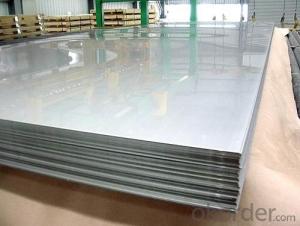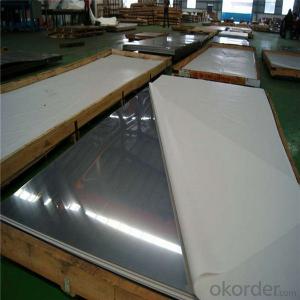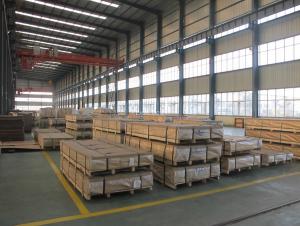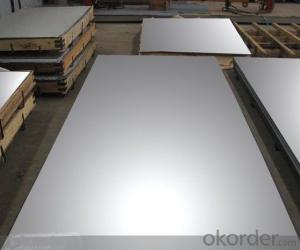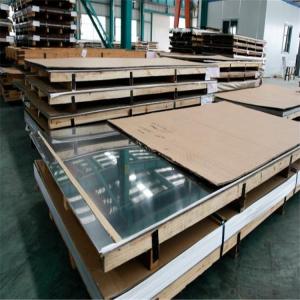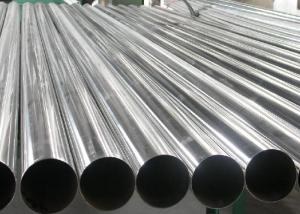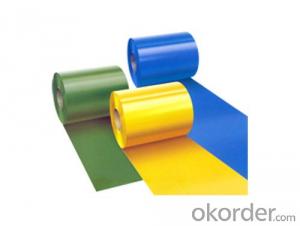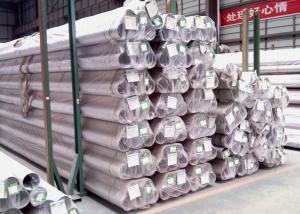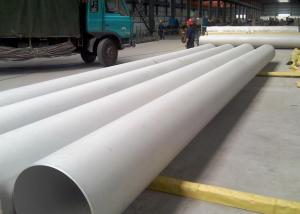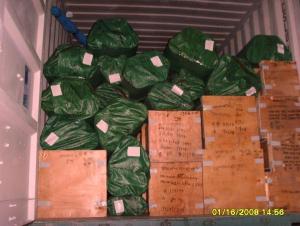Stainless Steel Sheet ASME 420 430 426 grade
- Loading Port:
- Shanghai
- Payment Terms:
- TT OR LC
- Min Order Qty:
- 7 m.t.
- Supply Capability:
- 1000 m.t./month
OKorder Service Pledge
OKorder Financial Service
You Might Also Like
Specification
Stainless steel sheet ASME 420 430 426 grade
Product Description
AISI 304( 18Cr-8Ni ) stainless steel is one of Austenitic stainless steel.
As a versatile steel, it has good corrosion resistance, heat resistance, low temperature strength
and mechanical properties. Meanwhile, it is quite good in pressing, bending and other thermal
processing.
Standard: ASTM A240 / A240M
Grade: 304 / 304L / 316 / 316L / 321 / 310S / 309S / 409 / 426 / 420 / 430 / 201...
Size: 1000*2000mm, 1220*2440mm, 1250*2500mm, 1500*3000/6000mm, 2000*6000mm
Special size can customized
Thickness: 0.3-20mm
Brand: TISCO, ZPSS, JISCO, BAO STEEL, LISCO
Surface: 2B, 2BA, BA, 1D, NO.1, NO.4, HL, Mirror, 8K
Chemical Composition
C | Cr | Ni | Mn | P | S | Mo | Si | |
304 | ≤0.07 | 17.00-19.00 | 8.00-10.00 | ≤2.00 | ≤0.035 | ≤0.030 | - | ≤1.00 |
304L | ≤0.030 | 18.00-20.00 | 8.00-10.00 | ≤2.00 | ≤0.035 | ≤0.030 | - | ≤1.00 |
316L | ≤0.030 | 16.00-18.00 | 12.00-15.00 | ≤2.00 | ≤0.035 | ≤0.030 | 2.00-3.00 | ≤1.00 |
317 | ≤0.12 | 18.00-20.00 | 11.00-15.00 | ≤2.00 | ≤0.035 | ≤0.030 | 3.00-4.00 | ≤1.00 |
317L | ≤0.08 | 18.00-20.00 | 11.00-15.00 | ≤2.00 | ≤0.035 | ≤0.030 | 3.00-4.00 | ≤1.00 |
309S | ≤0.08 | 22.00-24.00 | 12.00-15.00 | ≤2.00 | ≤0.035 | ≤0.030 | - | ≤1.00 |
310S | ≤0.08 | 24.00-26.00 | 19.00-22.00 | ≤2.00 | ≤0.035 | ≤0.030 | - | ≤1.00 |
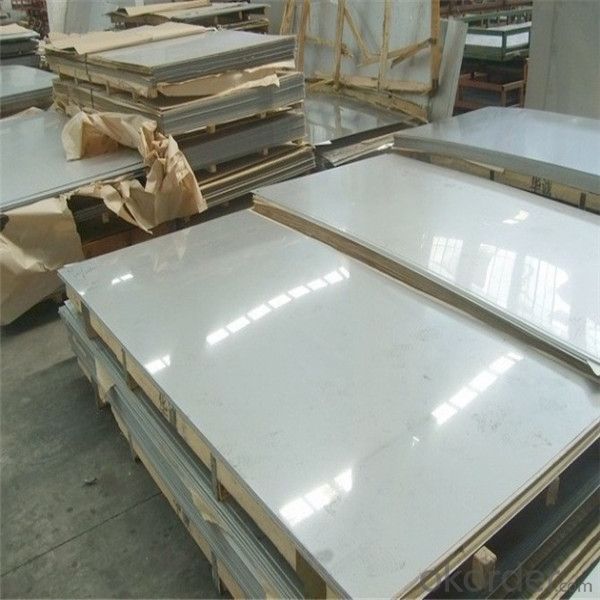
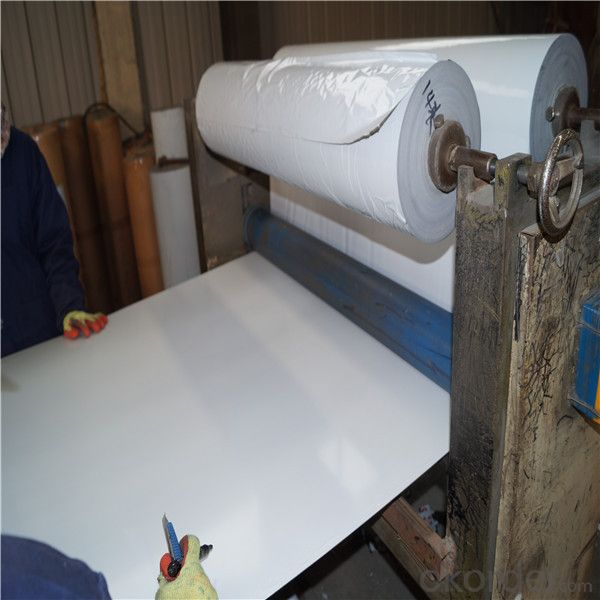
3. Applications
Stainless steel’s resistance to corrosion and staining, low maintenance and familiar lustre make it an ideal material for many applications. There are over 150 grades of stainless steel, of which fifteen are most commonly used. The alloy is milled into coils, sheets, plates, bars, wire, and tubing to be used in cookware, cutlery, household hardware, surgical instruments, major appliances, industrial equipment (for example, in sugar refineries) and as an automotive and aerospace structural alloy and construction material in large buildings. Storage tanks and tankers used to transport orange juice and other food are often made of stainless steel, because of its corrosion resistance and antibacterial properties. This also influences its use in commercial kitchens and food processing plants, as it can be steam-cleaned and sterilized and does not need paint or other surface finishes.
- Q: Can stainless steel sheets be bent?
- Stainless steel sheets have the capability to be bent. This material, known for its versatility, can be molded into different forms and designs, including bends. The capacity to bend stainless steel sheets relies on their thickness and composition. Generally, thinner sheets are more pliable and easier to bend, whereas thicker sheets might necessitate specialized tools and techniques. It is crucial to bear in mind that the bending procedure could potentially weaken the strength and durability of the stainless steel sheet. Therefore, careful thought should be given to the particular application and requirements before embarking on the bending of stainless steel sheets.
- Q: Are stainless steel sheets suitable for laboratory equipment?
- Yes, stainless steel sheets are suitable for laboratory equipment. Stainless steel is highly resistant to corrosion, easy to clean, and has excellent strength and durability, making it ideal for use in laboratory settings where hygiene and durability are crucial.
- Q: How do I prevent galvanic corrosion on stainless steel sheets?
- There are several measures that can be taken to prevent galvanic corrosion on stainless steel sheets: 1. Opt for a suitable stainless steel alloy: Select a grade of stainless steel, such as 316 or 317, which is less susceptible to galvanic corrosion compared to 304 stainless steel. 2. Keep dissimilar metals separate: Avoid direct contact between stainless steel sheets and other metals, particularly those with a higher potential for galvanic corrosion. If contact is necessary, use insulating materials like gaskets or rubber pads to create a barrier between the metals. 3. Apply protective coatings: Use specially designed protective coatings or paints for stainless steel to create a barrier that shields against galvanic corrosion. These coatings act as sacrificial layers, safeguarding the stainless steel from direct contact with corrosive substances. 4. Utilize isolation materials: Install insulating materials, such as plastic washers, insulating tape, or non-conductive gaskets, between stainless steel sheets and other dissimilar metals. This prevents direct electrical contact and subsequent corrosion. 5. Maintain proper upkeep: Regularly clean and inspect stainless steel sheets to remove any contaminants or foreign substances that may contribute to corrosion. Avoid using abrasive cleaners or tools that could damage the protective layer of the stainless steel. 6. Employ electrochemical protection: Implement cathodic protection techniques, such as sacrificial anodes or impressed current systems, to introduce an external source of electrons that counteracts galvanic corrosion. These methods help shift the corrosion potential of the stainless steel sheets to a more passive range. By adhering to these preventive measures, the risk of galvanic corrosion on stainless steel sheets can be significantly reduced. This ensures their longevity and helps maintain their structural integrity.
- Q: How do I prevent pitting on stainless steel sheets?
- To prevent pitting on stainless steel sheets, there are several steps you can take: 1. Choose the right grade of stainless steel: Different grades of stainless steel have varying resistance to corrosion. Opt for a higher-grade stainless steel, such as 316 or 304, which offer better resistance to pitting. 2. Proper cleaning and maintenance: Regularly clean the stainless steel sheets using mild soap or a non-abrasive cleaner. Avoid using harsh chemicals or abrasive scrubbers that can scratch the surface and create areas prone to pitting. 3. Avoid exposure to corrosive substances: Stainless steel sheets should be protected from prolonged exposure to corrosive substances like saltwater, strong acids, or chlorides. If the sheets are used in environments where exposure to these substances is unavoidable, consider applying a protective coating or finish. 4. Control the environment: Ensure that the stainless steel sheets are not exposed to excessive moisture, humidity, or high temperatures. These factors can accelerate corrosion and promote pitting. If possible, keep the sheets in a controlled environment with proper ventilation. 5. Regular inspection and maintenance: Perform regular inspections to identify any signs of pitting or corrosion. If pitting is detected, take immediate action to remove it and prevent further damage. Promptly repair any scratches or damages on the surface to prevent corrosion from starting. 6. Apply protective coatings: Consider applying a protective coating or film on the stainless steel sheets. These coatings act as a barrier against corrosive substances and can enhance the overall resistance to pitting. By following these preventive measures, you can minimize the risk of pitting on stainless steel sheets and ensure their longevity and durability.
- Q: What is the tensile strength of stainless steel sheets?
- The tensile strength of stainless steel sheets varies depending on the specific grade and thickness of the material. Generally, stainless steel sheets have a high tensile strength compared to other materials. For example, common grades such as 304 and 316 stainless steel sheets typically have tensile strengths ranging from 515 to 690 megapascals (MPa) or 74,800 to 100,000 pounds per square inch (psi). However, it is important to note that different grades and thicknesses of stainless steel sheets may have different tensile strength values. It is always recommended to consult the manufacturer or supplier for precise information on the tensile strength of specific stainless steel sheets.
- Q: Are stainless steel sheets suitable for elevator interiors?
- Yes, stainless steel sheets are highly suitable for elevator interiors. Stainless steel is a durable and versatile material that offers a range of benefits for elevator design and construction. Its strength and corrosion resistance make it ideal for withstanding the heavy use and potential exposure to moisture or chemicals commonly found in elevator environments. Stainless steel sheets can be easily customized and fabricated to fit specific elevator dimensions and designs. They can be polished to a high shine, giving a sleek and modern appearance that complements various interior styles. Additionally, stainless steel is easy to clean and maintain, making it a practical choice for high-traffic areas like elevators. Furthermore, stainless steel is a sustainable material, as it is fully recyclable and has a long lifespan, reducing the need for frequent replacements. It also offers excellent fire resistance, which is crucial for maintaining the safety of elevator occupants. Overall, stainless steel sheets provide a durable, aesthetically pleasing, and low-maintenance option for elevator interiors, making them highly suitable for use in elevators.
- Q: How do you determine the weight of a stainless steel sheet?
- To determine the weight of a stainless steel sheet, you need to know its dimensions (length, width, and thickness) and the density of stainless steel. By multiplying the volume of the sheet (length x width x thickness) with the density, you can calculate its weight.
- Q: What are the different types of stainless steel sheet alloys?
- There are several different types of stainless steel sheet alloys, including austenitic, ferritic, martensitic, and duplex stainless steel. Each alloy has unique characteristics and is suitable for various applications based on factors such as corrosion resistance, strength, and heat resistance.
- Q: Can stainless steel sheets be used for food processing?
- Yes, stainless steel sheets are commonly used in food processing due to their excellent corrosion resistance, durability, and ease of cleaning. They do not react with food, making them safe for use in various food processing applications such as food preparation surfaces, equipment, and storage containers.
- Q: What is the weight of stainless steel sheets?
- The weight of stainless steel sheets can vary depending on their thickness and dimensions. Generally, stainless steel sheets weigh between 1.5 to 3 pounds per square foot.
Send your message to us
Stainless Steel Sheet ASME 420 430 426 grade
- Loading Port:
- Shanghai
- Payment Terms:
- TT OR LC
- Min Order Qty:
- 7 m.t.
- Supply Capability:
- 1000 m.t./month
OKorder Service Pledge
OKorder Financial Service
Similar products
Hot products
Hot Searches
Related keywords

